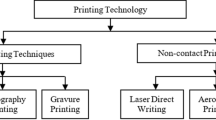Abstract
Electrically conductive adhesive (ECAs) have been used for many years in both the anisotropic conductive adhesive (ACA) and isotropic conductive adhesive (ICA) forms for microelectronic packaging applications and as an alternative to lead (Pb) soldering technology. Especially, environmentally friendly ICAs offer many advantages over solder, such as simple and low temperature process conditions and better thermo-mechanical performance. However, a number of reliability questions linger, and continue to be studied. In particular, the ICA-to-pad contact resistance can increase with time due to the galvanic corrosion of dissimilar contact and ICA-filler metals (Lu et al., IEEE Trans Electron Packag Manuf 22:228–232, 1999). ICAs are usually silver (Ag) epoxy composites, and the corrosion potential should be completely eliminated by the use of Ag contact pads. To completely eliminate lead (Pb) from electronics, the printed wiring board (PWB) must also change from hot-air-leveled solder (SnPb) to alternative metallic finishes, such as immersion-silver (Ag), immersion-tin (Sn), electroless nickel (Ni)/immersion-gold (Au) and organic solderability preservative (OSP) (Pas, in European institute of printed circuits summer conference, 2005). Especially, immersion-Ag is one of the leading Pb-free final finish choices for many OEMs in the telecommunications, computer, automotive and consumer electronics industries, because of its excellent properties and reasonable cost. This paper presents the electrical properties of Ag epoxy composite ICAs materials on Cu-finished and immersion-Ag finished PWBs, as solder replacements for SMT or flip chip technologies. All PWBs were subjected to 85°C/85% relative humidity (RH) aging testing, with junction resistance monitored for comparison of the immersion-Ag board to the Cu-finished board as a control. We expected that the corrosion potential, which is one of main causes to degrade conductivity between ICAs and PWB, should be eliminated by the use of Ag contact pads with the Ag epoxy composite ICAs materials. Not only is the junction resistance of immersion-Ag finished boards lower than that of Cu finished boards, but its junction resistance changes are smaller than those of Cu-finished boards, as expected.





Similar content being viewed by others
References
Jagt JC, Beris PJM, Lijten GFCM (1995) Electrically conductive adhesives: a prospective alternative for SMD soldering? IEEE Trans Compon Packag Manuf Technol B 18:292–298
Klosterman D, Li L, Morris JE (1998) Materials characterization, conduction development, and curing effects on reliability of isotropically conductive adhesives. IEEE Trans Compon Packag Manuf Technol A 21:23–31
Li L (1996) Basic and applied studies of electrically conductive Adhesives. PhD thesis, The State University of New York at Binghamton
Lu D, Tong QK, Wong CP (1999) Mechanisms underlying the unstable contact resistance of conductive adhesives. IEEE Trans Electron Packag Manuf 22:228–232. doi:10.1109/6104.795858
Lu D, Wong CP (2000) Development of conductive adhesives for solder replacement. IEEE Trans Compon Packag Technol 23:620–626. doi:10.1109/6144.888844
Lu D, Wong CP (2006) Overview of recent advances on isotropic conductive adhesives. In: Proc. of the 8th IEEE CPMT conference on high density microsystem design and packaging and component failure analysis
Mccarthy SL (1996) New test methods for evaluating electrically conductive adhesives. J Surf Mount Technol 9:19–26
Nguyen G, Williams J, Gibsion F, Winster T (1993) Electrical reliability of conductive adhesives for surface mount applications. In: Proc. of international electronic packaging conference
Pas FVD (2005) New, highest reliable generation of PWB surface finishes for lead-free soldering and future applications. In: European institute of printed circuits summer conference
Tong QK, Markley DL, Frederickson G, Kuder R, Lu D (1999) Conductive adhesives with stable contact resistance and superior impact performance. In: Proc. of the 49th electronic components and technology conference
Tummala RR, Rymaszewski EJ (1989) Microelectronics packaging handbook. Van Nostrand Reinhold, New York
Zwolinski M, Hickman J, Rubin H, Zaks Y, Mccarthy S, Hanlon T et al (1996) Electrically conductive adhesives for surface mount solder replacement. IEEE Trans Compon Packag Manuf Technol 19(Part C):241–250. doi:10.1109/3476.558550
Acknowledgments
The authors would like to thank Zymet Inc. and the National Starch and Chemical Company for the ICA materials and Merix Co. for donation of Cu-finished and immersion-Ag PWBs.
Author information
Authors and Affiliations
Corresponding author
Rights and permissions
About this article
Cite this article
Lee, J., Cho, C.S. & Morris, J.E. Electrical and reliability properties of isotropic conductive adhesives on immersion silver printed-circuit boards. Microsyst Technol 15, 145–149 (2009). https://doi.org/10.1007/s00542-008-0678-0
Received:
Accepted:
Published:
Issue Date:
DOI: https://doi.org/10.1007/s00542-008-0678-0




